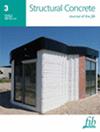The Pier Luigi Nervi's concrete structure of Palazzetto dello Sport: Modeling and dynamic characterization
IF 3.3
3区 工程技术
Q2 CONSTRUCTION & BUILDING TECHNOLOGY
引用次数: 0
Abstract
This paper presents a numerical and experimental study aimed at the modeling and dynamic characterization of the reinforced concrete structure of the Palazzetto dello Sport in Rome, designed and by Pier Luigi Nervi with Annibale Vitellozzi, and built by Nervi & Bartoli contractors in 1956‐57. An experimental dynamic testing campaign has been performed to obtain the modal properties of the structure, identified using operational modal analysis (OMA). The axial symmetry of the Palazzetto's dome, expected to exist in an idealized perfect dome, has been observed to occur experimentally by noting that rotated modes possessed nearly identical frequencies, evidenced by closely spaced double peaks in the power spectral density. This observation recognizes the remarkable precision of Nervi's construction methodology. A numerical 3D model has been developed by relying on detailed information about the structure gathered from various sources, including archival documents, on‐site testing, and surveying. The model has been calibrated by means of modal updating based on the experimental measurements collected in this study. The reconstruction of the dome using laser‐scanning and aerophotogrammetry has revealed a slight asymmetry in its thickness distribution (and consequently its mass distribution) that, when incorporated in the numerical model, has been shown to contribute to the experimentally observed frequency split. It is expected that, by tracking these closely spaced frequencies on top of the typical variations of natural frequencies in a health monitoring approach, further insight might be gained into the detection of possible damages and/or degradation of the structure and its components.皮埃尔-路易吉-内尔维的体育宫混凝土结构:建模和动态特性分析
该建筑由皮埃尔-路易吉-内尔维(Pier Luigi Nervi)和安尼巴莱-维特罗齐(Annibale Vitellozzi)设计,1956-57 年由内尔维 & Bartoli 承包商建造。为了获得该结构的模态特性,采用运行模态分析法(OMA)对其进行了试验性动态测试。在理想化的完美穹顶结构中,Palazzetto 的穹顶结构具有轴对称性,但在实验中却发现旋转模态具有几乎相同的频率,功率谱密度中间隔很近的双峰证明了这一点。这一观察结果证明了 Nervi 建造方法的非凡精确性。根据从档案文件、现场测试和勘测等各种来源收集到的有关结构的详细信息,我们开发了一个三维数字模型。根据本研究收集的实验测量数据,通过模态更新对模型进行了校准。利用激光扫描和航空摄影测量重建的穹顶显示,其厚度分布(以及质量分布)存在轻微的不对称。预计通过在健康监测方法中对自然频率典型变化的基础上跟踪这些间隔较近的频率,可以进一步深入探测结构及其组件可能出现的损坏和/或退化。
本文章由计算机程序翻译,如有差异,请以英文原文为准。
求助全文
约1分钟内获得全文
求助全文
来源期刊

Structural Concrete
CONSTRUCTION & BUILDING TECHNOLOGY-ENGINEERING, CIVIL
CiteScore
5.60
自引率
15.60%
发文量
284
审稿时长
3 months
期刊介绍:
Structural Concrete, the official journal of the fib, provides conceptual and procedural guidance in the field of concrete construction, and features peer-reviewed papers, keynote research and industry news covering all aspects of the design, construction, performance in service and demolition of concrete structures.
Main topics:
design, construction, performance in service, conservation (assessment, maintenance, strengthening) and demolition of concrete structures
research about the behaviour of concrete structures
development of design methods
fib Model Code
sustainability of concrete structures.
 求助内容:
求助内容: 应助结果提醒方式:
应助结果提醒方式:


